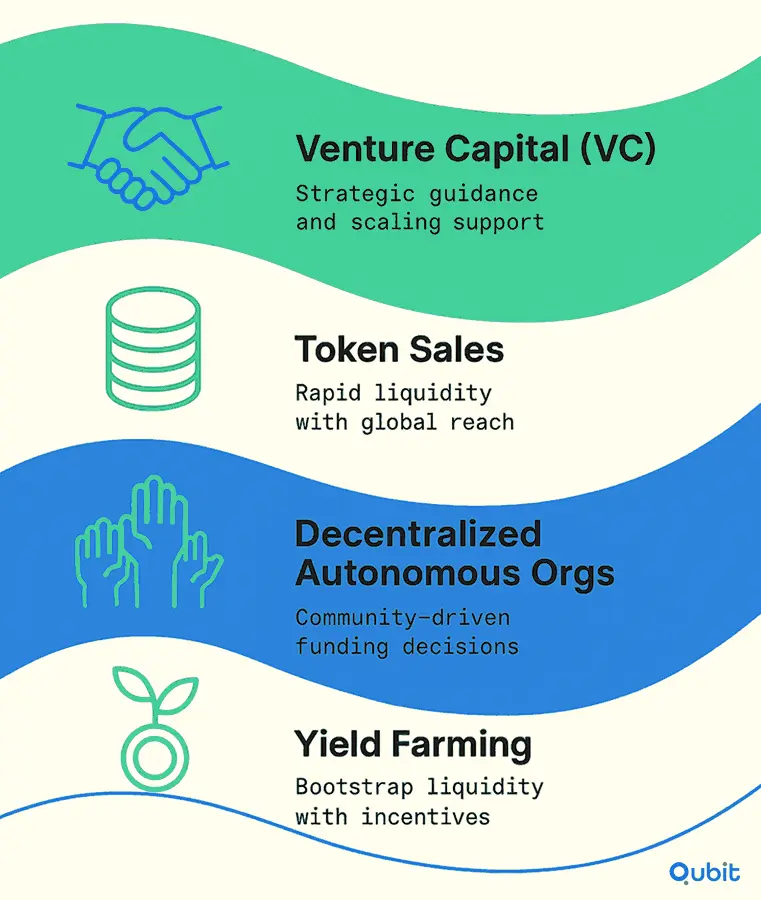Decentralized Finance (DeFi) is transforming how blockchain startups access capital, scale, and build community trust. In 2025, DeFi projects raised $763 million in a single quarter, while total blockchain and crypto startup funding hit $4.8 billion. As a founder, you need to know the funding mechanisms that matter most, both for raising capital and for building sustainable, community-driven ecosystems.
Below, you’ll find a comprehensive breakdown of DeFi funding models, how they work, and actionable insights for founders.
The DeFi Funding Revolution
DeFi’s rise has democratized access to capital for blockchain projects. Unlike traditional finance, where a handful of VCs control the purse strings, DeFi enables anyone, anywhere, to participate in funding and governance. In 2025, over 40% of all new blockchain projects leveraged DeFi-native funding models, up from just 15% in 2022. This shift is not just about capital, it’s about building community, transparency, and long-term alignment.
Core DeFi Funding Models, What Every Blockchain Founder Should Master

1. Venture Capital (VC) in DeFi
Traditional VC funding remains a major force, especially for early-stage DeFi projects. VCs offer more than just capital—they bring strategic guidance, technical expertise, and access to a deep network of industry contacts. In 2025, VCs are focusing on foundational blockchain technologies, cybersecurity, and tokenization of real-world assets, not just speculative tokens.
- Why it matters: VC support can help refine your product-market fit and scale infrastructure.
- Tip for founders: Build relationships with VCs who understand DeFi’s regulatory and technical landscape. Highlight your compliance roadmap and security audits.
2. Token Sales (ICOs, IEOs, STOs)
Token sales democratize fundraising by allowing anyone to participate. Initial Coin Offerings (ICOs), Initial Exchange Offerings (IEOs), and Security Token Offerings (STOs) are common models. These sales can provide rapid liquidity and foster a global user base.
- Why it matters: Token sales can raise millions in days, but require careful compliance and community management.
- Tip for founders: Prioritize transparency, clear tokenomics, and robust security to build trust. For more, see blockchain fundraising strategies.
3. Decentralized Autonomous Organizations (DAOs)
DAOs are community-governed entities where token holders vote on funding allocations, project direction, and protocol upgrades. DAOs can raise capital through treasury sales, grants, or partnerships, ensuring that the community has a real stake in the project’s future.
- Why it matters: DAOs enable decentralized decision-making and align incentives between founders and users.
- Tip for founders: Engage your community early and often. Use DAOs to fund ecosystem development and incentivize long-term participation.
4. Yield Farming and Liquidity Mining
Yield farming and liquidity mining reward users for providing liquidity to DeFi protocols. By locking assets in smart contracts, users earn returns—often in the form of governance tokens or protocol fees.
- Why it matters: These models bootstrap liquidity and foster community engagement, but can introduce volatility.
- Tip for founders: Design sustainable reward structures and educate users about risks. Explore more in DeFi liquidity funding.
Emerging DeFi Funding Models and Innovations
NFT Collateralization and Digital Asset Funding
Non-fungible tokens (NFTs) are now being used as collateral for loans and liquidity provision. This model unlocks new capital sources for projects with valuable digital assets, creating a bridge between DeFi and the rapidly growing NFT market.
- Why it matters: NFT collateralization diversifies funding and attracts new user segments.
- Tip for founders: Partner with NFT projects and explore cross-protocol integrations for broader market reach.
Institutional Investment and Hybrid Models
Institutional investors are entering DeFi, bringing regulated capital and credibility. Hybrid models combine traditional VC oversight with decentralized governance, allowing projects to access both worlds.
- Why it matters: Institutional money can accelerate growth and improve compliance standards.
- Tip for founders: Prepare for rigorous due diligence. Highlight your security audits and regulatory readiness.
Cross-Chain Liquidity and Unified Yield Strategies
Fragmented liquidity has long been a pain point in DeFi. In 2025, cross-chain interoperability solutions like LayerZero and Axelar enable seamless asset transfers and unified liquidity pools across multiple blockchains. This allows users to supply capital to several chains from one vault, maximizing efficiency and yield.
- Why it matters: Cross-chain liquidity attracts larger investors and supports higher capital efficiency.
- Tip for founders: Integrate with leading interoperability protocols to expand your user base and liquidity options. For more, see DeFi investment trends.
Managing Risk and Compliance in DeFi Funding
Regulatory uncertainty and smart contract vulnerabilities are top concerns for both founders and investors. In 2025, projects that prioritize security audits, transparent governance, and compliance with evolving regulations are more likely to attract sustainable funding.
- Why it matters: Security breaches or regulatory actions can destroy user trust and halt funding.
- Tip for founders: Invest in third-party audits, maintain open communication about risks, and stay informed about global compliance trends. Dive deeper into DeFi compliance.
Community Building and Governance as Funding Levers
DeFi’s most successful projects are those that turn users into stakeholders. Community-driven funding models, such as DAOs and governance token allocations, are driving long-term engagement and capital retention.
- Why it matters: Projects with active communities and transparent governance attract more funding and higher valuations.
- Founder tip: Launch community grant programs, incentivize participation, and use on-chain voting for key decisions.
Stablecoins and Liquidity Pools, Fueling DeFi Capital Flows
Stablecoins are the backbone of DeFi liquidity. In 2025, over $150 billion in stablecoins circulates across DeFi protocols, powering lending, trading, and yield farming.
- Why it matters: Stablecoins reduce volatility, making DeFi funding more predictable and accessible.
- Founder tip: Integrate stablecoin support and design liquidity pools with attractive, sustainable incentives.
Case Studies: How Top DeFi Startups Raised Capital
Uniswap
Uniswap initially secured a small venture capital round in 2019, with investments from Paradigm, USV, and Variant. The protocol then scaled globally by launching the UNI governance token in September 2020, distributing tokens to early users and liquidity providers. This move kickstarted liquidity mining, incentivizing users to add capital to Uniswap pools. The Uniswap DAO treasury, funded by token allocations and protocol fees, now manages over $2 billion in assets, publicly verifiable through on-chain data and DAO governance dashboards.
Aave
Aave started as ETHLend, raising funds through an Initial Coin Offering (ICO) in 2017. After rebranding to Aave, the project attracted additional venture capital and institutional investment, including from Standard Crypto and Blockchain.com Ventures. Aave further expanded capital through liquidity mining programs, distributing AAVE tokens to users who supplied or borrowed assets. The protocol’s growth and credibility have also attracted institutional partnerships, as seen in Aave Arc, a permissioned liquidity pool for institutions. All funding rounds, token distributions, and partnerships are documented in Aave’s public governance forum and blockchain records.
Conclusion
DeFi is rewriting the rules of blockchain fundraising. By understanding and leveraging diverse funding models, founders can access global capital, build resilient ecosystems, and drive the next wave of financial innovation. The future belongs to projects that balance decentralization, compliance, and community empowerment.
If you're ready to secure your next round of funding, we at Qubit Capital are here to assist. Our Fundraising Assistance service is designed to support your journey toward success. Let’s work together to turn your vision into reality.
Key Takeaways
- DeFi funding models include VC, token sales, DAOs, yield farming, NFT collateralization, and institutional hybrids.
- Cross-chain liquidity and compliance are defining trends for 2025.
- Security, transparency, and community engagement are essential for sustainable DeFi fundraising.
Frequently asked Questions
What is the most popular DeFi funding model in 2025?
Token sales and DAOs remain popular, but hybrid models with institutional backing are gaining ground.


 Back
Back



